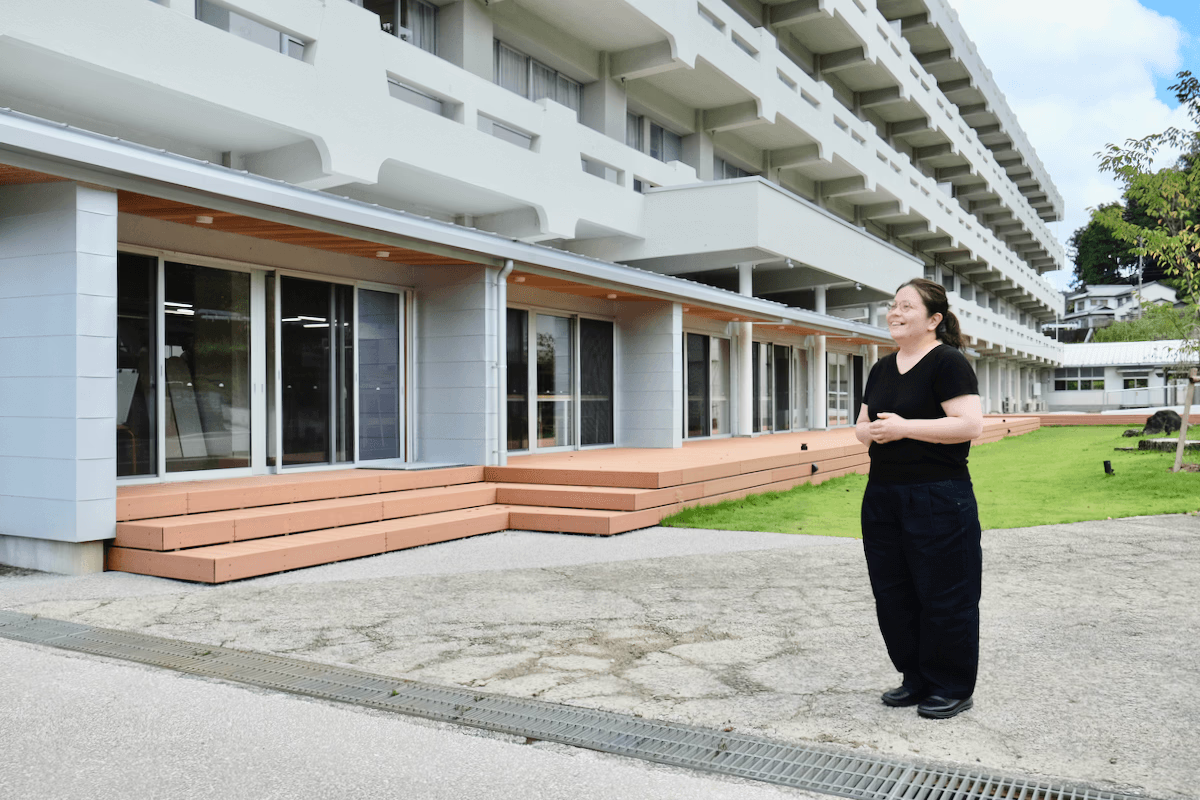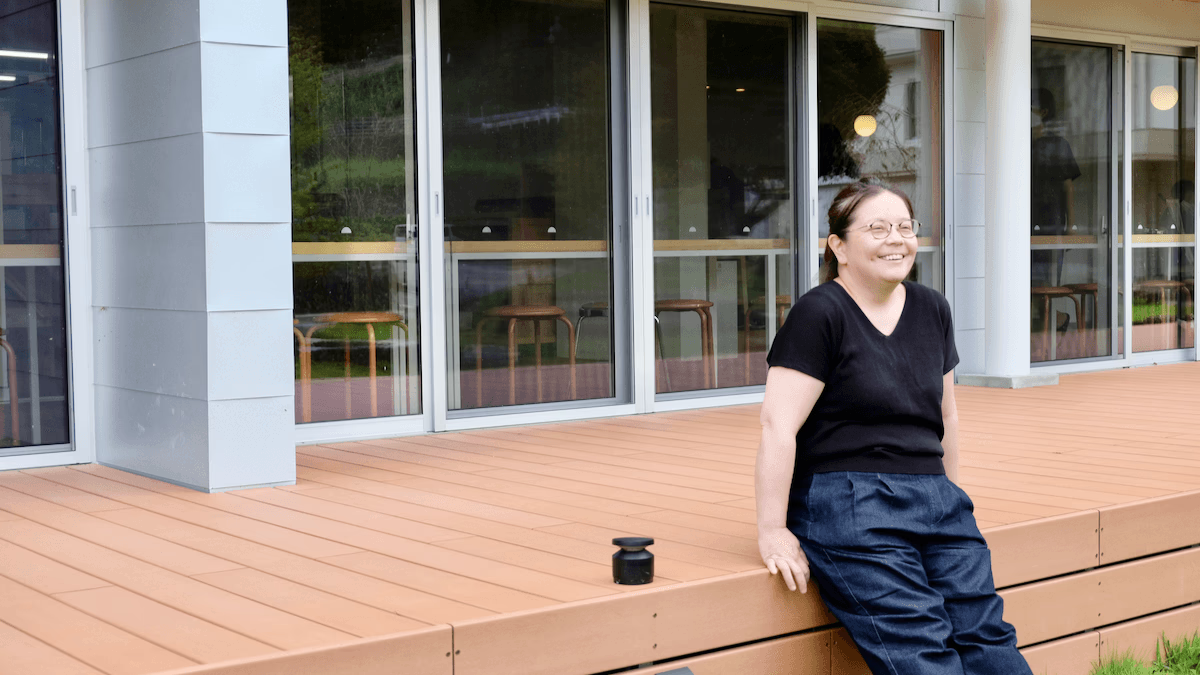「細井さんのごはん」と聞くだけで鳴いてしまう胃袋をもつみなさん、お待たせしました!
神山フードハブ・プロジェクト、代々木・FarmMart & Friends、九段食堂、そして神山まるごと高専の学食『まるごと食堂』など、モノサスが手がける食事業のほぼすべてに、関わっている細井恵子さんにインタビューしました。
タイトルでは「料理人」と書きましたが、細井さんの仕事はその概念の枠内に留まっていません。料理、デザート、商品・メニュー開発、ケータリング、レストランのサービスまで、オールラウンドにやってしまうプロフェッショナルな人です。
今回の「めぐるものさし」では、細井さんが歩んできた食の道について、そして彼女の「おいしい」というものさしについて聞かせていただきました。
1978年東京生。箱根のリゾートホテルで製菓を担当したのち、株式会社GEORGE’S FURNITURE(現ウェルカム)に入社。TABLE MODERN SERVICE自由が丘(現・TODAY’S SPECIAL Kitchen)、HOUSE西麻布にて各種商品開発および調理、青山THREEの立ち上げと店長を経験。東京DEAN&DELUCAのベーカリーでは年間約50種類の企画商品を開発した。2016年に独立。徳島・神山フードハブ・プロジェクトの料理長、東京・神田ブラインドドンキーのフロアマネージャー、東京・FarmMart & Friends、東京・九段食堂の新規立ち上げに伴うメニュー開発やオペレーション構築をする。2022年から、徳島・神山まるごと高専の学生食堂「まるごと食堂」の料理長としてメニュー開発やオペレーション構築に関わっている。
小さいときから料理の仕事をすると決めていた
― 細井さんは、どこで料理の仕事をはじめたんですか?
細井:最初に就職したのは、箱根にあるリゾートホテルの製菓でしたが、すごくお菓子をやりたかったというわけではなくてたまたまなんですよ。当時はどんどん違うことをしてみたくて、「料理の仕事がしたい」という大枠のなかで、タイミングが合う仕事に飛び込んでいました。
23歳のときに、GEORGE’S FURNITURE(現・ウェルカム)に入社して、自由が丘のカフェで働いたのち、京都のカフェ「ask a giraffe」に異動しました。ホテルでは上長が考えたレシピに沿ってつくっていましたが、ask a giraffeには同世代の人たちがスキルを持ち寄って新しい商品を企画できる環境がありました。最初はデザート担当でしたが、「料理が好きならやってみたら?」と言われて、ランチやマンスリーメニューの開発もやるようになりました。
ウェルカム時代は、レストラン「HOUSE 西麻布」でワインやサービス、グルテンフリーのカフェ「RIVIVE KITCHEN(現・THE THREE)」で店長を経験しました。このとき、小麦粉をまったく使わずに料理もデザートも提供したことによって、私のなかで「グルテンフリーはおいしくない」「小麦粉がないとできない」という固定観念が一気に吹っ飛びました。アレルギーがある人もない人も、みんながおいしく食べられる制限食は成立するし、その制限自体を楽しむこともできると思えたのは大きなターニングポイントになりました。
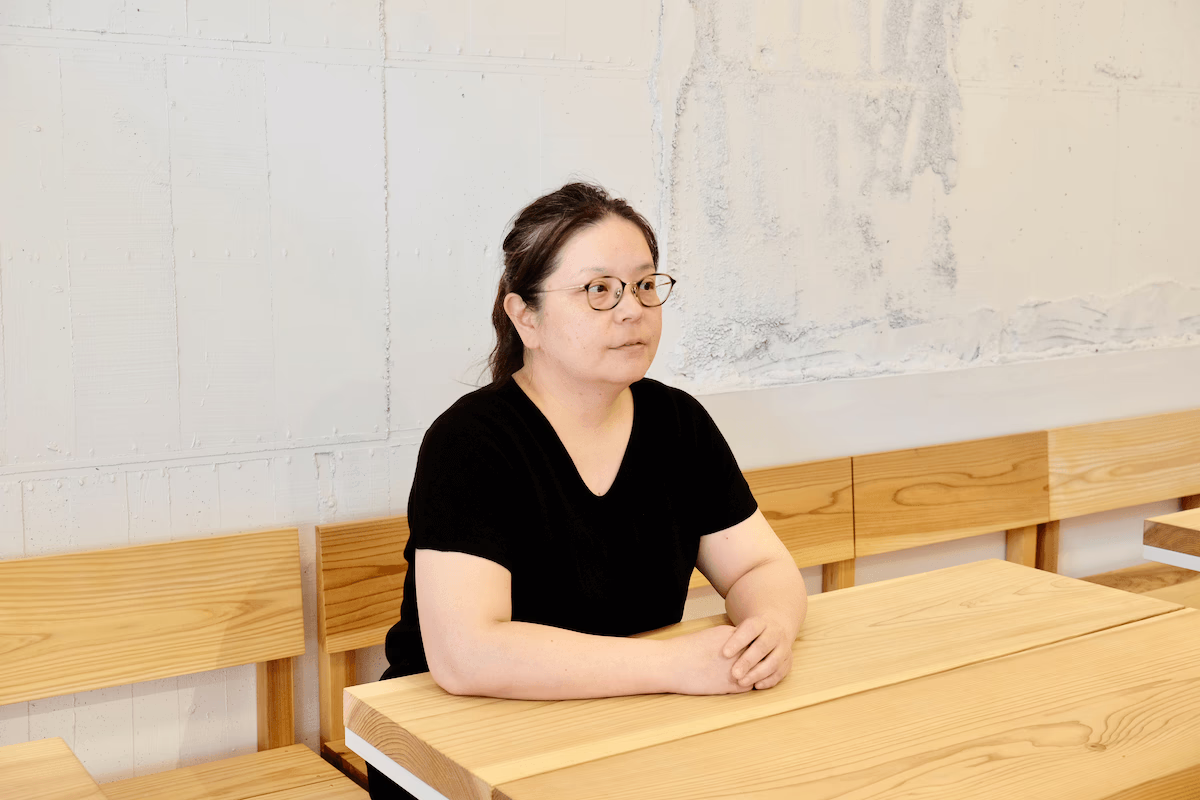
― その後、DEAN & DELUCAの商品開発もしていたと聞きました。
細井:DEAN & DELUCAでは、ベーカリーやサンドイッチの商品開発をしていました。レシピをつくって原価を計算して、食材調達の手はずを整えて。一工程ずつ写真を撮ったレシピを各店舗に渡すのですが、それぞれ調理環境が違うので現場を回ってレシピを調整するのがすごい大変でした。また、DEAN & DELUCAは年間100種類くらいメニューが変わるので、多いときは月10品目以上試作していました。試食会でプレゼンするとすごいズバズバ言われるんですよ。それがすごく大変だったけど楽しくもありました。
なおかつ、DEAN & DELUCAには、何かあれば周りの人が絶対に助けてくれる環境が整っていました。開発で迷ったときも「ちょっと相談していいですか?」というと前のめりに聞いてくれるし、何かあるとみんながバババッて動くチーム感があって。こういうチームの作り方もあるんだって新鮮だったし勉強にもなりました。
ものすごく大変だったフードハブの立ち上げ
― 神山でフードハブ・プロジェクトの立ち上げに参加した経緯は?
細井:DEAN & DELUCAを辞めて「そろそろ自分で何かやってみようかな」と考えていたタイミングで、モノサスの真鍋(太一)さんから「フードハブを一緒にやらないか」と誘ってもらいました。
真鍋さんとの出会いは、2011年にシェパニーズ(Chez Panisse)のメンバーが各地を巡る食のイベント「OPENharvest」でした。当時、私はHOUSE西麻布にいて、一日だけポップアップで参加したんです。その後もeatripの野村友里さんたちと真鍋さんがやっていた「Nomadic Kitchen」に帯同させてもらったり、モノサスの周年パーティで料理をつくらせてもらったりと、ご一緒する機会が増えていって。プライベートでも飲みに行ったりしていたんですよね。
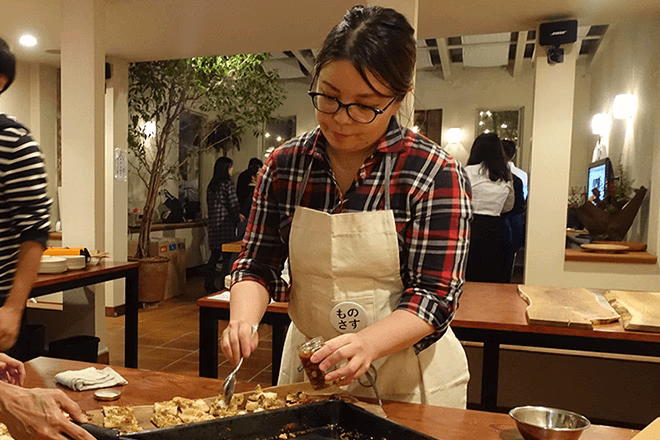
モノサス創立11周年記念パーティでデザートを用意してくれた細井さん(2015年)
― 真鍋さんと一緒に仕事したいと思ったのはどうしてだったんですか。
細井:食に対する考え方を話していてまったく違和感がなかったんですよね。「おいしいお店には絶対理由があるよね」「つくり手と食べ手の関係は対等であるべきだよね」とか。あとはやっぱり、真鍋さんの仕事の推進力かな。それについていくのはしんどいんですけどね(笑)。
― フードハブの立ち上げは、それまでの経験と比べてどうでしたか。
細井:農業チーム、パン屋、食堂、食育、加工を一気に立ち上げたので、ものすごく大変でした。「ふつうはまずどれかひとつでしょ?」って(笑)。今はもうあんなことできないなって思いますもん。
― 細井さんは、農業以外はほぼ全部に関わっていましたよね。
細井:はい。フードハブで仕入れる食材の選定基準表の製作、食堂とパン屋のメニュー開発、加工品の開発、食堂のオペレーションやイベントの企画運営……。レジや調理場の機材の選定、保健所への申請に至るまで、基本的には全部関わっていました。
― そういうとき「料理人なんだから、レジ選ぶのは私の仕事じゃないですよね?」とか、そういう気持ちにはならなかったんですか?
細井:真鍋さんが全部やる人なので、一緒に仕事していると「そういうものなんだな」って思っちゃうんですよね。それに、フードハブの初期メンバーは誰も「これは私の仕事じゃないですよね」って一切言いませんでした。「じゃあこうしようか」「誰がやる?」みたいな感じでものごとが進んでいって。初期メンバーはだいぶフットワーク軽く「まずは行ってみる」みたいな感じで。たとえば、食材の選定基準表をつくるときも、みんなで醤油蔵や味噌蔵を尋ねて、直接話を聞いて理解したうえで「じゃあ、この商品を仕入れよう」と決めていました。みんなすごい熱量だったなと思います。
学生食堂は「家族の食卓」
― 神山まるごと高専の学生食堂「まるごと食堂」でのお仕事はいかがですか。
細井:ウェルカムで培ったリサーチ力、DEAN & DELUCAで評価された開発力、フードハブでの食材選定や九段食堂でのオペレーションなど、今までやってきたことをすべて集約してできているから、うまくハマっているなと思いますね。仕事のストレスも一番少ないんですよ。
ー まるごと食堂では、地元の食材をつかった定食も、ちょっと気楽で学生に人気のある「明太うどん」も出していて。毎食つくる2種類のメニューは、どんなふうに考えてつくっていますか?
細井:私のなかでまるごと食堂は“家”だと思っているので、「家族にふるまうならどんなごはんをつくるか?」という視点でつくっています。料理人としての一番のミッションは、おいしく安心して食べられて、毎日「あー、どっち食べよう?」と迷えるメニューを考えること。管理栄養士さんのアドバイスを受けながら栄養価を整えたり、一食あたりの原価の計算をしたりもするけど、意識しすぎないようにしています。
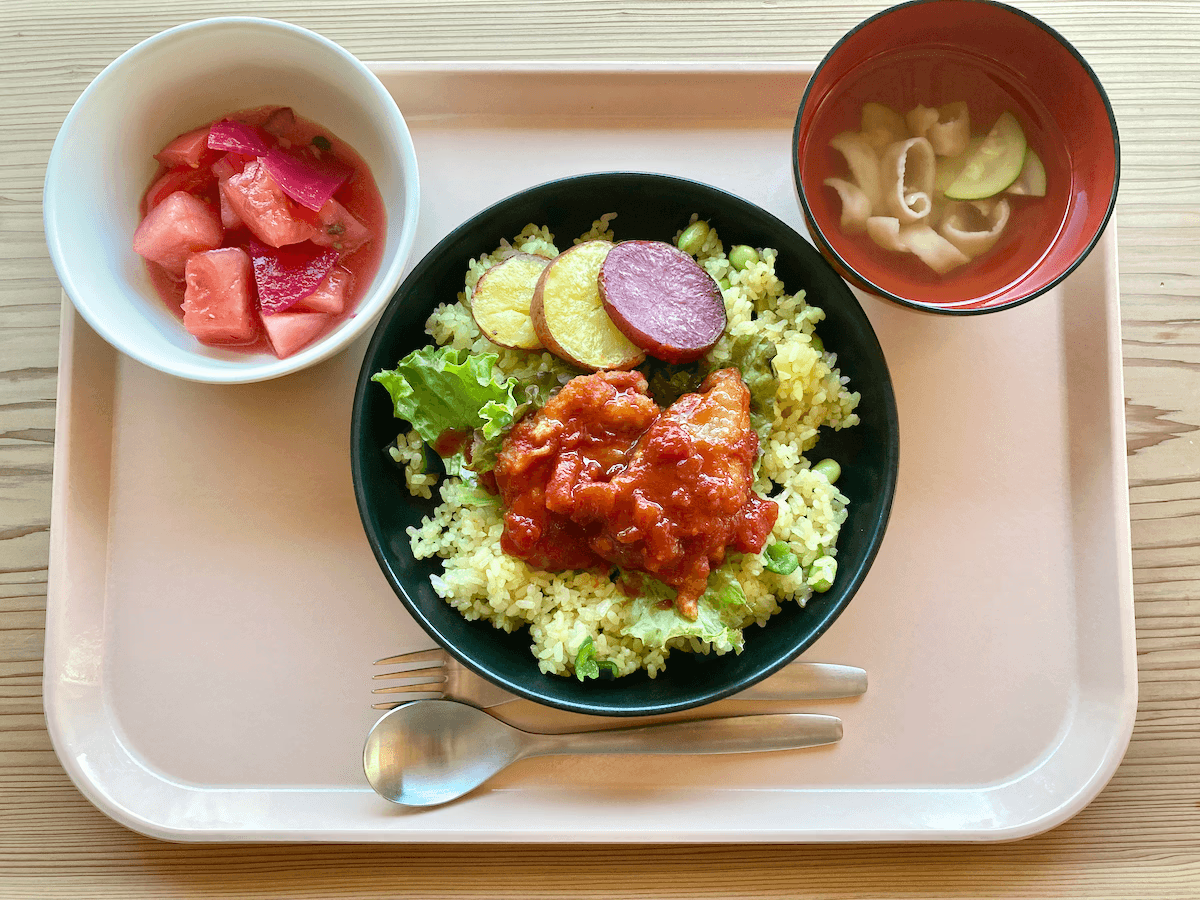
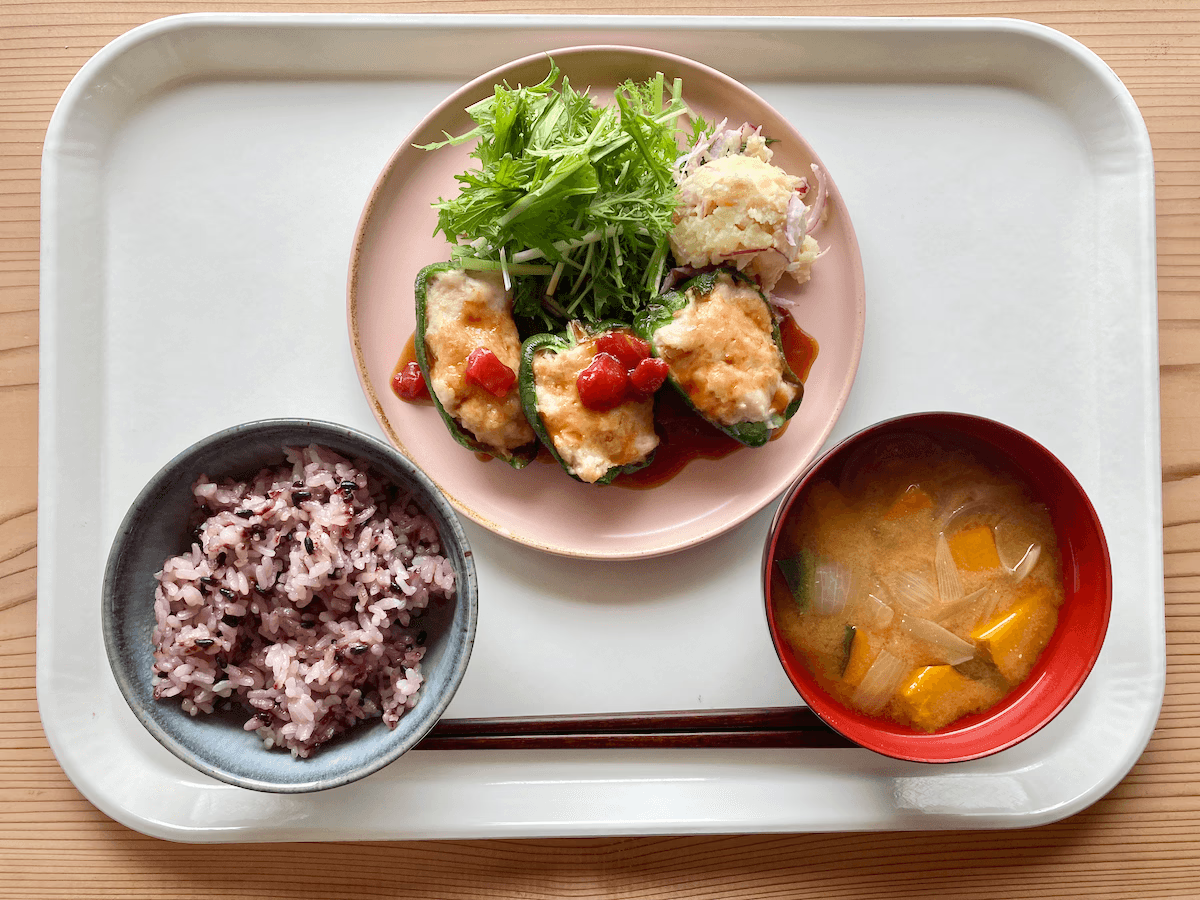
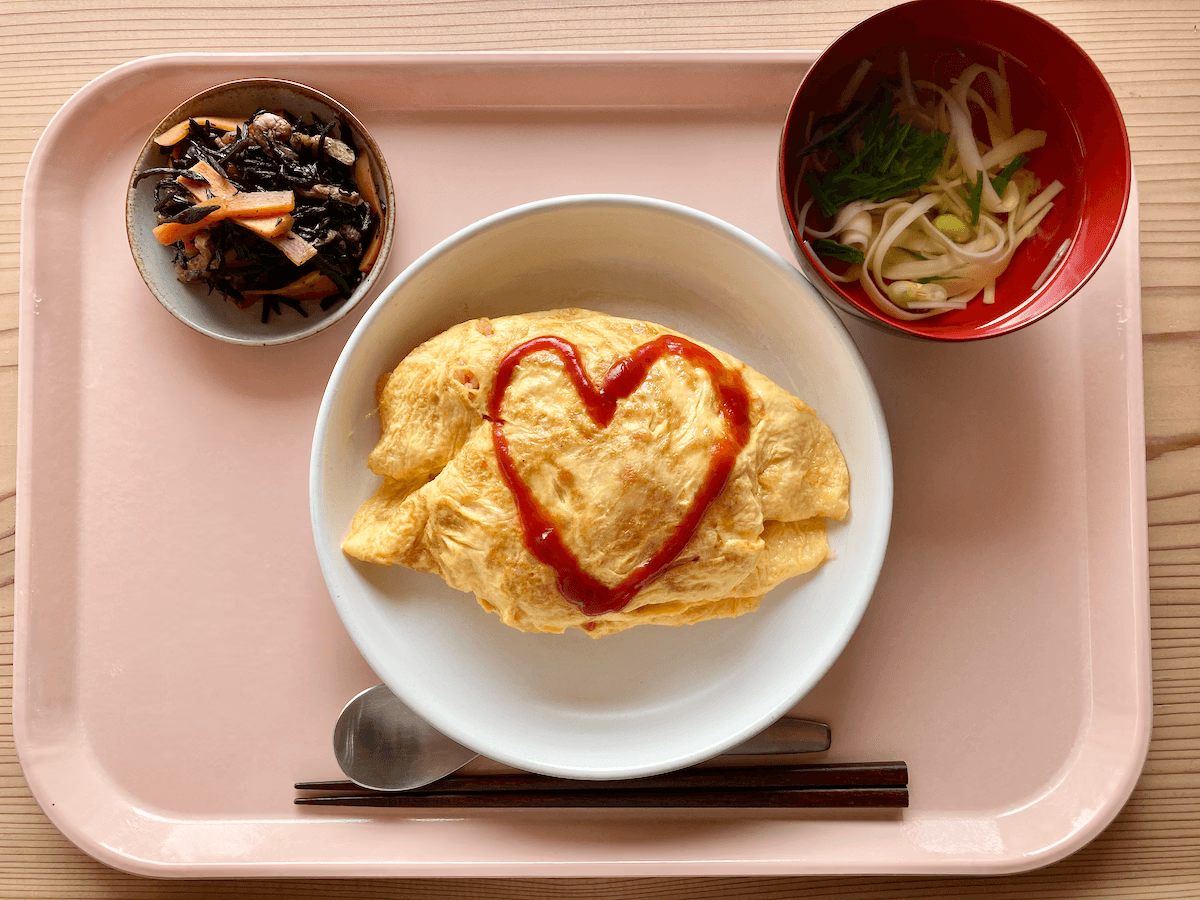
細井さんが考えた「まるごと食堂」のメニュー。若い舌は敏感で、「お味噌汁のお出しを変えたらおかわりが増えた」と細井さん
― 毎日違うメニューを考えつづけるのは大変じゃないですか?
細井:そこはあまり苦じゃないですね。フードハブの「かま屋」でやってきたメニューでも3000くらいのデータがありますし、たとえば同じハンバーグでもソースを変えれば味は違うし、載せる野菜が変われば目先も変わります。それに毎食2種類出しているので、同じメニューを出しても半分の学生にとっては食べたことがないメニューになります。
いろいろ出してみるうちに、「パスタは人気がある」「お昼は定食より手軽に食べられるうどんや丼が喜ばれる」とかわかってきましたし、学生に「今日はなんでこっちにしたの?」と聞いて参考にすることもあります。わたしのなかでは、おいしいものをつくって喜ばれるのは大前提。「おいしい」と言われるのは当然なんです。すでに、「おいしいものをつくる人」という信頼は得られたので、そうじゃないところの引き出しをどう開けるかを考えています。
―「そうじゃないところの引き出し」って?
細井:たとえば、ふだんはちょっとしか食べない女の子たちがおかわりしにくるときは、やっぱり理由があるんですよね。食べたことのない食材に対して「他にどんな食べ方があるんですか?」とか、「これはどうやってつくるんですか?」とか、「おいしい」以外のひとことが出てくることが、「これは成功したな」と思えるひとつの指針になっています。その気づきから、たとえば一次産業に興味をもつとか、何かにつながるかもしれないですよね。
私からは、「何を食べたい?」と聞くことはまったくないです。あるとき、学生たちがメニューボードの下に「給食リクエスト」を書いていたことがあったんだけど、そういうのでいいんですよ。あくまで見守る体制でいて、伝えてもらったことに対して返していけばいいと思っています。
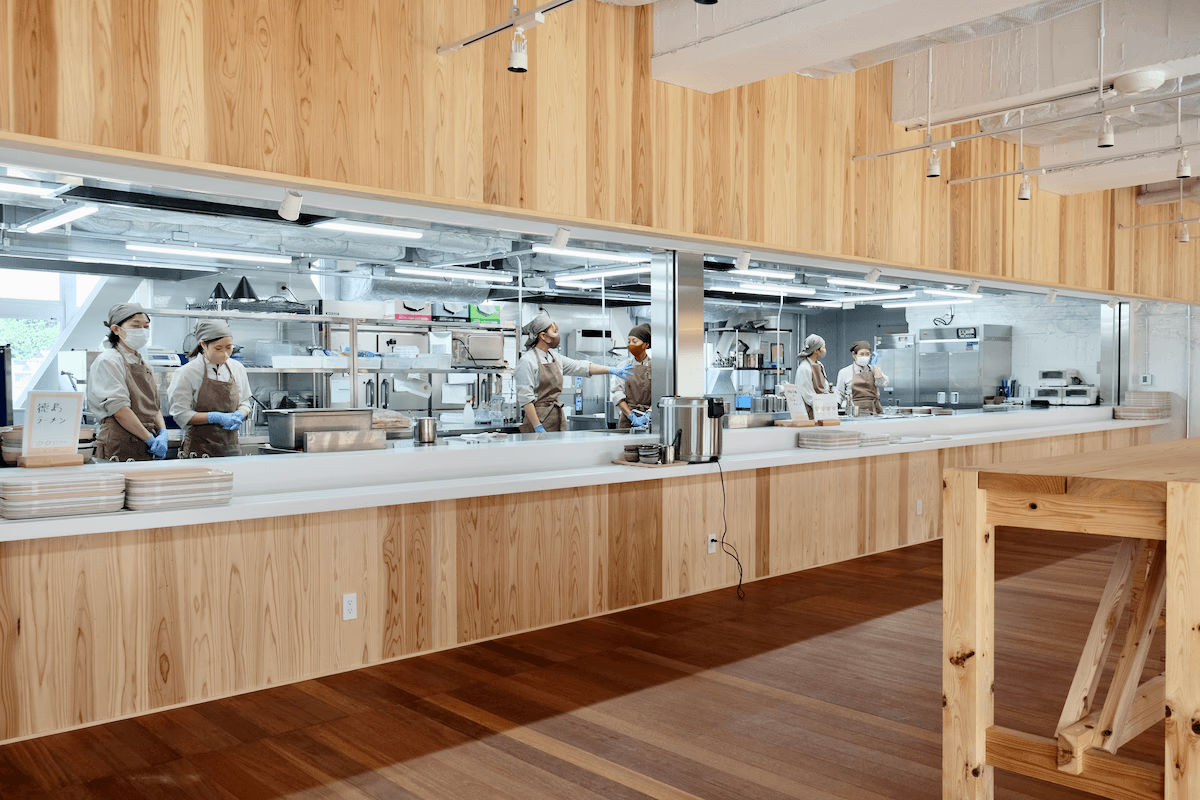
ランチタイム直前、学生たちを待っている厨房
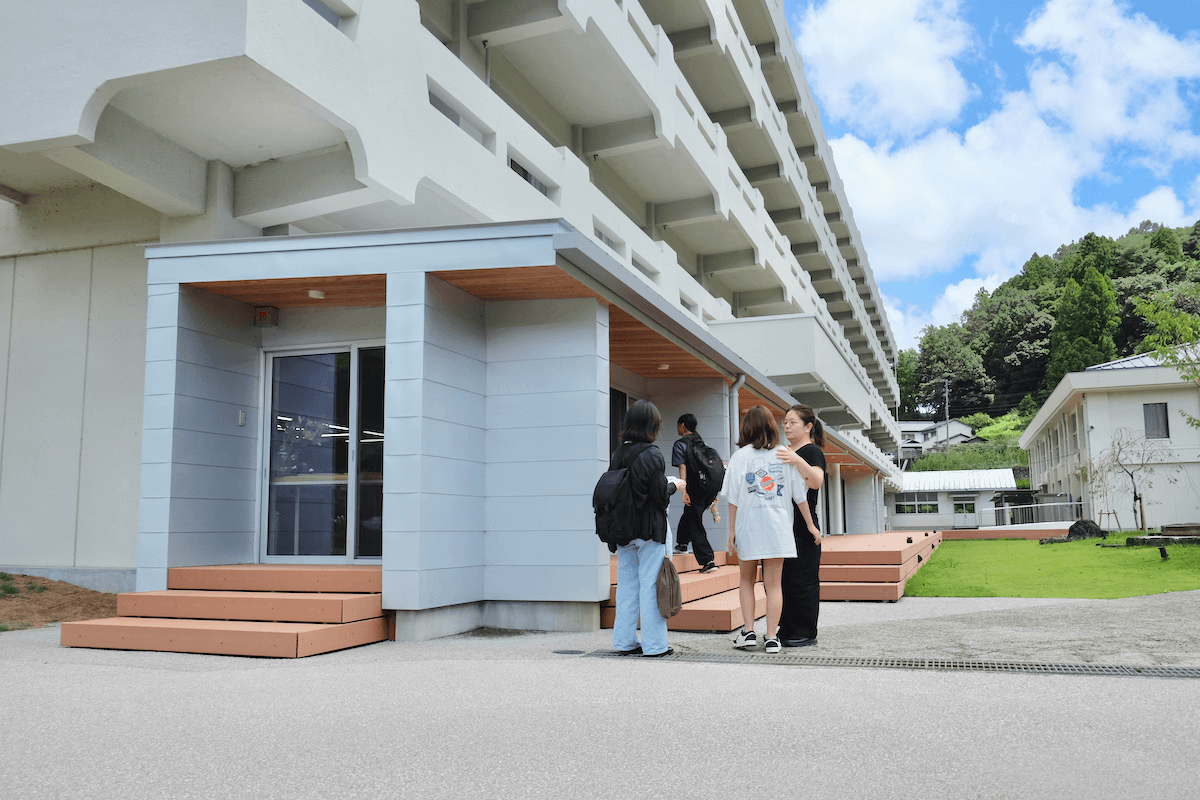
細井さんの姿を見ると学生たちが自然と声をかけにくる
― ふだん、学生とはどんな話をしているんですか?
細井:わたしは“お母さん”ではなく、16歳の子たちと対等でいたいと思っていて。「そのネイルかわいいじゃん。どこでやったの?」とか「パーマどこでかけたの?」とか。日常のちょっとした変化に気づいたら声をかけます。若い子の間で流行っていることを勉強もして、「何が好きなの?」って聞いたりすることもあります。
最近、学生の名前とそれぞれの好みをノートに記録しているんです。レストランでも、グラスが空になったときに「次、どうします?」って言われると「見てくれているんだな」って安心しますよね。それと同じ感覚かもしれない。
料理の原点にある「おもてなし」
― そもそも、細井さんが料理を好きになったのはいつだったんですか?
細井:子どもの頃からですね。祖母の家では何か行事があるたびに家で料理をつくってふるまっていて、台所に立つ祖母や母がかっこいいなと思っていたし、子どもながらにお手伝いするのが楽しかったんです。食べる人のことを考えながらごはんをつくる。それをふるまっておもてなしする。好きなんですよね、そういうのが。
― 以前、細井さんのご自宅に伺ったとき、もちろんごはんは最高においしかったのですが、それと同じくらい居心地よく過ごさせてもらえました。「喉乾いたな」「お風呂入りたいな」と思うちょっと手前で、すっと差し出してくれて。細井さんにとって、料理人のお仕事は「料理をつくって出す」で終わらなくて、「食べる」を包む時間と空間全部をつくろうとしているのかなと思ったんです。いったい、どこまでを「料理人の仕事」として見ているんですか?
細井:えー? 考えたことないですね。やれることは全部やるっていうスタンスだから。
旅が好きで、家族経営のこじんまりした宿に泊まりにいくんですけど。ごはんをつくって、お風呂の準備をして、お部屋を整えてお客さまをお迎えしてくれて、「もう全部だな」と思います。その宿が醸し出す雰囲気が好きだし、日常的なホスピタリティを感じると幸せなんですよ。自分もそうありたいと思っているから、そういう宿を選ぶんだろうしね。
最近、料理もひとくち食べて「おいしいね。ほんとうによかったね。ごちそうさまでした」みたいな、気楽な幸せが一番豊かだなと思っているんです。「これは何が入っているんだろう」と難しいことを考えながら食べるんじゃなくて、もう脱力してほしいんですよね。
― 食べる側にいるとき、細井さんの「おいしい」には幅があるなと思っていて。味を求めてきちんとしたレストランに行くこともあれば、気のおけない町の食堂や居酒屋にも行きますよね。
細井:その意味での「おいしい」は、味だけじゃないと思うんです。居心地やお店の雰囲気をひっくるめて「おいしい」につながるというか。私が、ただおいしい料理をつくるだけに満足せずに、フロアのサービスや料理チームとのコミュニケーションの取り方まで気になるのは、その全部があって「おいしい」につながると思っているからです。「おいしい」には、「この場所いいね」「この空間はなんか落ち着くね」という感じも含まれていると思います。
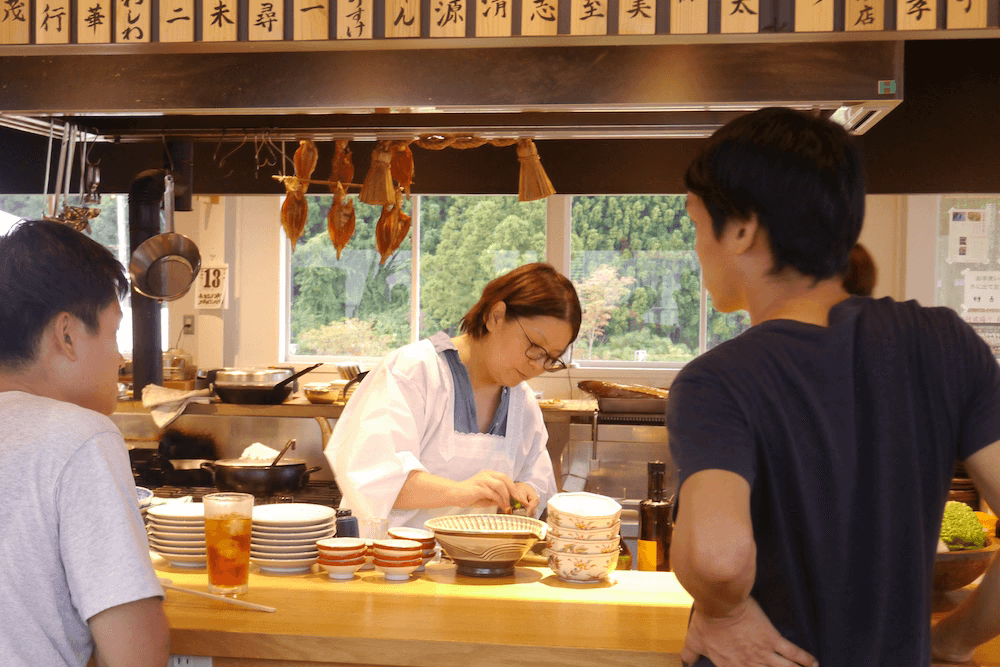
フードハブ・プロジェクトの食堂「かま屋」で開催した「居酒屋けいこ」にて。(フードハブ「活動日誌」より)
食に関わることはもはや「ライフスタイル」
― 独立してからもう七年が過ぎましたね。今後、どんなふうに仕事をしたいと思っていますか?
細井:いつか自分でやるのなら、こじんまりと目の届く範囲で、細々と続けていけるスタイルのことをやれたらいいかな。ここまでいろいろ経験してきたことを生かしながら、自分に無理なく生きていければいいかなと思っています。どちらかというとひとりや少人数でいるのが好きなタイプだけど、おもてなしをしたいと思うのは、たぶん人が好きなんでしょうね。
― もう、貪欲に学ぶ時代は過ぎたというか。
細井:食に関して貪欲に学ぶというのは永遠に続いていくもので、それはもうライフスタイルになっちゃっているから。旅に行っても何か食べたり、生産者さんのところに寄ったりするので、年中働いていると思われているのですが、私にとっては単なる休息なんです。それが他の人には「仕事」に見えるのなら、もうライフスタイルなんだろうなと思うようになりました。
― 一緒にごはんを食べに行くとき、厨房を見るのかなと思ったらそうでもないですね。
細井:おいしいものを食べに行くときは、食べることに集中したいんですよ。そのなかで、「グジの皮がおいしいな」と思ったら、他の人が頼んだときに皮の焼き方だけパッと見るかもしれないけど。
― 最後に聞いてみたいのですが、仕事で落ち込むときってどうしていますか?
細井:自分の納得するクオリティを出せないとメンタルがやられちゃうんですよ。「なんで、あんなの出しちゃったんだろー!」みたいな。たとえば、ケータリングで「冷めたときの味は予想と違ったな」ということがあります。食べた人は「ふつうにおいしいですよ」って言ってくれるかもしれないけど、自分が納得できないともうズタボロです。そういうときは、Instagramで海外のケータリングの写真を見ながら試作して、基本を紐解いてから自分の色をつけて「次はこうしよう」と考えたりします。
最近は、料理だけにこだわりすぎると凝り固まるなと思っていて。今年一月に市川團十郎の舞台を観に行ったんです。幕が開いた瞬間、セリフを言っているわけでもないのに気迫を感じて号泣してしまいました。ものすごく努力している方のオーラってやっぱりあって。そういうものを感じると刺激になるので、料理以外のものにも目を向けるのは必要だなと改めて思いました。
― ありがとうございました。また「おいしい」をご一緒してください。
おいしいものをおいしく食べてもらうこと、おいしいものをおいしく食べること。
細井さんは、料理している姿がとてもきれいです。大きなボウルを抱えてサラダをつくっていたり、まな板で野菜をトントン切っていたり、フライパンでお肉を焼いていたり。そのようすをすごく鮮明に思い出せます。料理されている食材も、細井さんの手の中ですっかり安心しているような気がするほどに調和しています。出された料理を食べているわたしも、あの野菜たちみたいに安心しているんだろうな。
「おいしいものには理由がある」と細井さんは言っていたけれど、彼女が料理している姿を見ているとほんとうにそうだなと思います。「おいしい」を説明する情報に頼るのではなく、ちゃんと自分の感性で受け止めて、つくり手との対等な関係をつくること。それが、「おいしいものをおいしく食べる」ことなんじゃないかな、と思います。
